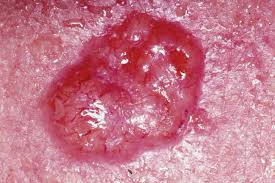That my friends, is skin cancer. I think that it is pretty disgusting if you ask me. Do you agree? Skin cancer comes in many types, the two most common are nonmelanoma and melanoma. They account for around for half of all the reported cancers. Melanoma is way more dangerous than nonmelanoma. When you get diagnosed with nonmelanoma there is a 50% chance that you get diagnosed with skin cancer again in around five years of the initial diagnosis.
There are many ways to know if you have skin cancer. Some ways are if you see an unusual growth, mole, or abnormal appearance on the skin. These growths can range from being red, pink, black, blue, brown, or flesh-colored. There are many things that increase your chance of getting skin cancer, such as being exposed to arsenic, coal, tar, HPV, genital warts, chronic inflammatory skin disease, long-term treatment for psoriasis, earlier radiation treatments, immune suppression, and xeroderma pigmentosum. Those are the specific ones, a more basic one is being outside to long without the proper care for your skin. It is also recommended that you avoid sunlamps and tanning beds.
There are 3 ways of trying to cure skin cancer. The first is, if it is diagnosed early nonmelanoma can be cured with minor surgery to remove the affected area. Removal may be done by freezing them with liquid nitrogen, or you can cut them with a laser. In some superficial cancers it can be removed simply by scraping it off, and then anything left over will be killed with electricity. The second option being radiation therapy, radiation therapy is used to kill very small cancer cells or slow down the reproduction process of the larger ones. It may sometimes be used to kill any left over cancer cells from surgery. Side effects include: vomiting, diarrhea, fatigue, or skin irritation resembling a sunburn or suntan. The third and final option is Chemotherapy. Chemotherapy would be done by applying a chemotherapeutic agent to the affected tissue, doing this would reduce the side effects from radiation therapy. In rare cases where the cancer has spread to underneath the skin to distant tissue, systemic chemo may be required.
<
What is the most cost effective way of treatment?
What is the quickest way of treatment?
What age group has the biggest risk of getting skin cancer?

